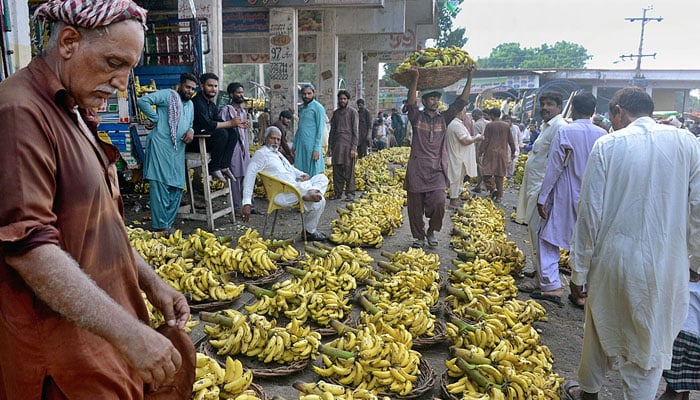November 02, 2023  Traders displaying bananas during the auction as shopkeepers participate in the bidding of bananas at the Fruit Market on October 10, 2023. — APP.
Traders displaying bananas during the auction as shopkeepers participate in the bidding of bananas at the Fruit Market on October 10, 2023. — APP.
ISLAMABAD: Pakistan’s inflation rate significantly decelerated to 26.9 percent in October 2023, from a four-month high of 31.4 percent observed in September, says an official bulletin released on Wednesday.
This rate is the lowest since December 2022, primarily due to a substantial drop in food inflation to a 16-month low of 26.8 percent, compared to the previous month’s 33.1 percent.
The average inflation for the first four months of FY2023-24 reached 28.5 percent. This reading is still higher than the government’s target of 21 percent for the ongoing FY24, the Pakistan Bureau of Statistics (PBS) CPI (consumer price index) bulletin said.
Notably, in May 2023, inflation was at its record peak of 38 percent. Since November 2021, inflation remained persistently elevated and in double-digit territory.
It further says that in October, the prices of alcoholic beverages and tobacco saw a rise of 84.6 percent, compared to 87.5 percent in September. The category of recreation and culture also witnessed a notable increase, with a jump of 56.3 percent, slightly lower than the 58.8 percent recorded in September.
Furthermore, furnishings experienced a significant uptick of 37.1 percent, down from 39.3 percent in the previous month. Notably, food inflation in October decreased to 26.8 percent, compared to 33.1 percent in the previous month.
In October, there were several notable changes in prices. Hotel charges increased by 33 percent, slightly lower than the 34.3 percent in September. Transport expenses remained consistent at 31.3 percent, as in September.
Housing and utilities increased by 20.5 percent, a decrease from the previous month’s 29.7 percent. Health expenses also saw a slight decrease to 25.2 percent from 25.3 percent. Clothing and footwear remained stable at 20.6 percent, and education expenses increased to 12.8 percent from 11.1 percent.
Over September, the inflation increased by 1.1 percent, following a 2 percent increase in the prior month.
Notably, the core inflation, which excludes food and energy components, arrives at 18.5 percent against 18.6 percent in September and 18.4 percent in August.
The wholesale price index (WPI), a measure of producer prices, rose to 24.6 percent in October from 26.4 percent in September. The sensitive price indicator (SPI), which tracks the prices of essential items on a weekly basis, increased to 34.2 percent in October from 32 percent in September.
Rural inflation was significantly higher at 28.9 percent than the inflation of 25.5 percent in urban centers. Over the previous month, both urban and rural inflations increased by 1.1 percent. On a month-on-month basis, onions price increased by 38.7pc, fresh vegetables 17.7 pc, fresh fruits 6.5pc, eggs 6pc, potatoes 3.7pc, fish 3pc, condiments and spices 2.87pc, beans 1.5pc and nimco 1.4pc over the previous month. However, sugar price got reduced by 10.2pc, gram pulse by 3.7pc, tomatoes 3.1pc, mustard oil by 2.3pc, moong pulse by 2.1pc, gur by 1.9pc, wheat flour by 1.9pc, fresh milk, tea, and wheat price reduced by 1.7 percent each. Similarly, vegetable ghee, besan, and masoor pulse prices are down by 1.6pc each. Cooking oil prices were also reduced by 1.5 percent over the previous month. Among non-food items, electricity charges increased 8.3pc in one month, marriage hall charges 5.4pc, accommodation services 4.5pc, liquefied hydrocarbons 3.9pc, drugs and medicines 3.7pc, education 3.2pc, Doctor (MBBS) clinic fee 3pc, woolen readymade garments 2.4pc, therapeutic appliances and equipment 2.3pc, electrical appliances for personal 2pc, furniture & furnishing 1.96pc and woolen cloth 1.9pc.
However, motor fuel prices were reduced by 4pc, transport services by 1.6pc and construction input items prices down by a percent over the previous month. On a year-on-year basis, condiments and spices prices increased 85pc, sugar 70pc, gur 65, wheat flour 63pc, rice 62pc, beans 57pc, tea 55pc, beverages 46pc, wheat products 43pc, dry fruits 42pc, dessert preparation 42pc, potatoes 41pc, mash pulse 40pc, wheat 38pc, and milk powder were costlier by 37 percent over the last year. However, tomato prices reduced 46pc, onions 17pc, fresh vegetables 11pc and gram pulse by 3.4pc. Likewise, among the non-food items, on a yearly basis, textbooks were costlier by 95pc, gas charges 63pc, electricity charges 51pc, washing soap/detergents/matchbox 48pc, stationery 47pc, communication apparatus 40pc, household equipment 37pc, marriage hall charges 37pc, drugs and medicines 37pc, newspapers 34pc, personal effects 33pc, accommodation services 32pc, motor fuel 31pc, motor vehicle accessories 28pc and solid fuel cost increased by 27pc.












